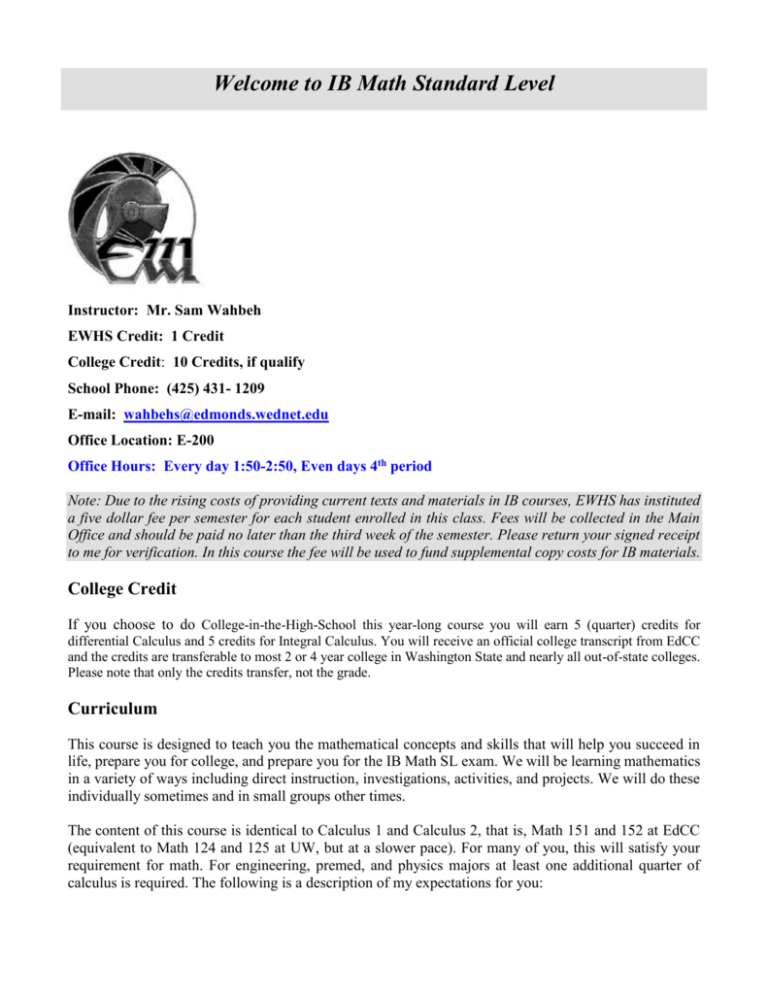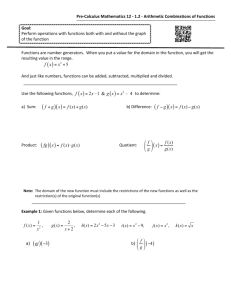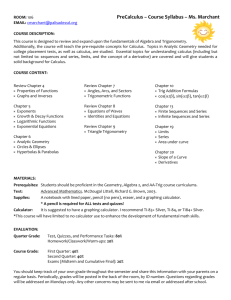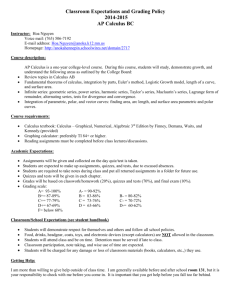
Welcome to IB Math Standard Level
Instructor: Mr. Sam Wahbeh
EWHS Credit: 1 Credit
College Credit: 10 Credits, if qualify
School Phone: (425) 431- 1209
E-mail: wahbehs@edmonds.wednet.edu
Office Location: E-200
Office Hours: Every day 1:50-2:50, Even days 4th period
Note: Due to the rising costs of providing current texts and materials in IB courses, EWHS has instituted
a five dollar fee per semester for each student enrolled in this class. Fees will be collected in the Main
Office and should be paid no later than the third week of the semester. Please return your signed receipt
to me for verification. In this course the fee will be used to fund supplemental copy costs for IB materials.
College Credit
If you choose to do College-in-the-High-School this year-long course you will earn 5 (quarter) credits for
differential Calculus and 5 credits for Integral Calculus. You will receive an official college transcript from EdCC
and the credits are transferable to most 2 or 4 year college in Washington State and nearly all out-of-state colleges.
Please note that only the credits transfer, not the grade.
Curriculum
This course is designed to teach you the mathematical concepts and skills that will help you succeed in
life, prepare you for college, and prepare you for the IB Math SL exam. We will be learning mathematics
in a variety of ways including direct instruction, investigations, activities, and projects. We will do these
individually sometimes and in small groups other times.
The content of this course is identical to Calculus 1 and Calculus 2, that is, Math 151 and 152 at EdCC
(equivalent to Math 124 and 125 at UW, but at a slower pace). For many of you, this will satisfy your
requirement for math. For engineering, premed, and physics majors at least one additional quarter of
calculus is required. The following is a description of my expectations for you:
Materials to Bring Every Day
Textbook (Covered)
Pencil and eraser
Notebook Paper or Spiral Notebook
Graphing Calculator (TI-83 or TI-84)
Centimeter Ruler
Colored Pencils or Pens
Grading
Your grade will be based on homework/classwork, quizzes, tests, and a semester final exam.
Homework/classwork will constitute 10% of your grades, quiz and test scores will be worth 80%, and the
semester final will be worth 10%. Final grades will be rounded to the nearest percent and based on the
following intervals:
A
A–
B+
B
93% – 100%
90% – 92%
87% – 89%
83% – 86%
B–
C+
C
C–
80% – 82%
77% – 79%
73% – 76%
70% – 72%
D+
D
F
67% – 69%
60% – 66%
Below 60%
Homework/Homework 10%
You will be given homework every class session. You are expected to complete your homework before
the following session. It is your responsibility to correct and revise your own work and seek extra help
when necessary. Doing homework on a regular basis is the single most important factor in learning
mathematics. The habit of doing your homework regularly and focusing on understanding (not just
completion) will prepare you for learning the next lesson and give you the necessary practice to prepare
you for tests and quizzes. Homework from the previous class will be checked or collected each day. Perfect
assignments (complete, work shown, corrections made, headed and labeled properly) will be given full
credit, which is 4 points. Late homework will not be accepted for credit and assignments that are
plagiarized or copied will result in a grade of zero for all individuals involved and may lead to loss of
credit in the course (see the “Academic Honesty” section in your student planner).
Quizzes & Tests 80%, Final Exam 10%
Each class period I will try to give a one problem quiz from the homework to check for accuracy. The
quiz will be worth 0, 3, or 5 points. Only perfect and accurate work will be awarded 5 points. Tests will
always be announced; quizzes may or may not be announced. Tests and quizzes help me determine how
well you have learned course content. They will always cover material from the homework and any other
in-class activities we’ve done. You may only make up a test if you have an excused absence. If you have
an unexcused absence on the day of a test, you will be given a zero on that test. If you have an excused
absence on the day of a test, then you must take a different version of the test within one week of the date
of the exam unless other arrangements are made due to extraordinary circumstances. Re-tests will not be
given, so make sure you study hard and do your best the first time. Work on tests and quizzes must be the
original work of the student. Assessments that are plagiarized or copied will result in a grade of zero for
all individuals involved and may lead to loss of credit in the course (see the “Academic Honesty” section
in your student planner). Note that final exam will be worth 10% of your grade.
Tardy Policy
It is a big disruption when you are late to class. I expect you to be in your assigned seat when the bell
rings. If you are not, and you don’t have a note from another teacher, you will be marked tardy. You will
be warned after the first and second occurrences, and given 30 minutes detention after the third. A onehour detention will be given after the fourth tardy, and a two-hour detention given after the fifth. After
any further tardiness, you will be referred to the Dean of Students. Please do not be late to class.
Attendance Policy
Absences, excused or unexcused, will affect your progress in class. Students are fully expected to be on
time and in class EVERY DAY. The majority of learning in this class will occur during class participation
and discussion. Your grade will be affected because of this. An absence will be marked if you are more
than 10 minutes late to class. Additionally any class work missed or not turned in due to an unexcused
absence will not be accepted.
Class Expectations
Please realize that it is my job to maintain a safe and effective learning environment in my classroom and
that there are consequences for misbehavior. I will always deal with you first in resolving disciplinary
matters, but if we cannot solve the problem between the two of us, your parents and/or school
administrators may become involved. In addition to these basic expectations, there will be NO
ELECTRONIC DEVICES (mobile phones, mp3 players, etc.) and NO FOOD OR DRINK allowed in the
classroom, except for a re-sealable bottle of water. If you carry cell phone, please keep it turned off while
in class, including no text messaging or using it as a calculator.
Participation is a huge part of this class. This course will require energy, effort, and enthusiasm. It will be
difficult and rewarding. Students are expected to be engaged and have an answer ready for every question.
I will be available during advisory and after school for extra help. Please take advantage of extra help.
The following are five goals I have for you this year. All of my decisions will be made with helping you
reach these goals. I challenge you to do the same.
The Big Five Goals:
1) Be respectful
2) Be responsible
3) Strengthen your mind
4) Connect with the material
5) Be an enthusiastic learner
The following are three keys to success in math class. If you do these three things you will succeed this
year.
Three Keys to Success:
1) Actively participate in class
2) Stay focus on the task at hand
3) Ask questions when you don’t understand
Course Content, Sequencing, and Timing
This course will use as its primary resource the textbook Calculus: Graphical, Numerical, Algebraic, 3rd
edition (AP Edition) by Finney, Demana, Waits, and Kennedy, Pearson Prentice Hall Publishing © 2007.
The course topics will be learned using the textbook chapters listed below. We will also use the textbook
Mathematics Standard Level by Buchanan, Fensom Kemp, Rondie and Stevens, Oxford University Press.
The approximate number of 95-minute class periods dedicated to each chapter, including tests and quizzes,
is indicated to the right of each chapter title.
Chapter 2: Limits and Continuity
Rates of Change and Limits
Limits Involving Infinity
Continuity
Rates of Change and Tangent Lines
Chapter 3: Derivatives
Definition of Derivative
Differentiability
Rules for Differentiation (Including product and quotient rules)
Velocity and Other Rates of Change
Derivatives of Trigonometric Functions
Chain Rule
Implicit Differentiation
Derivatives of Exponential and Logarithmic Functions
Chapter 4: Applications of Derivatives
Extreme Values of Functions
Mean Value Theorem
Concavity and Points of Inflection
Modeling and Optimization
Related Rates
Chapter 5: The Definite Integral
Estimating with Finite Sums (rectangular approximation methods)
Definite Integrals and Area
Definite Integrals and Antiderivative Properties
Fundamental Theorem of Calculus
Trapezoidal and Simpson’s Rules
Chapter 6: Differential Equations and Modeling
Slope Fields
Antidifferentiation by Substitution
Exponential Growth and Decay
Chapter 7: Applications of Definite Integrals
Integral as a Net Change
Areas in the Plane
Volumes
Applications from Science and Statistics
Teaching Strategies Incorporated in the Course
Multiple Representations
Essentially every topic covered in this class will be approached from multiple perspectives. You will learn
calculus from graphical (graphs), numerical (tables), analytical (by hand/no calculator), and verbal (oral
and written) points of view. Not only will you learn how to approach calculus from these perspectives,
but you will learn to use the different approaches in conjunction with each other to confirm and further
support your solutions.
Technology
You will be required to have a TI-84 graphing calculator for this course. You will be taught how to use
the calculator to analyze functions graphically and numerically, to find zeroes of functions, to solve
complex equations, and to differentiate and integrate numerically. Graphing calculators and other
mathematical technology are powerful tools for solving problems and make many topics accessible that
would not be otherwise. In addition, graphing calculators are powerful learning tools and using them to
help you visualize and analyze patterns will deepen your conceptual understanding of calculus.
Applications
In addition to learning theoretical mathematics, you will be learning most of the course topics in real-life
contexts. You will be using calculus to solve interesting problems from biology, business, chemistry,
economics, engineering, finance, physics, social science, and statistics. Being able to attach the theory
with how it is used in practice will solidify your understanding calculus and show you many situations in
which calculus is actually used in the world to solve problems. This may also spark an interest in how you
can use mathematics in your future career.
Writing and Explaining/Demonstrating Conceptual Understanding
You will frequently be working in groups in this class to explore situations and to solve problems. The
benefits to working in groups are numerous. First of all you are exposed to perspectives and problem
solving approaches that are different than those you would come up with on your own. These experiences
will broaden your own set of approaches and allow you to develop more diverse strategies for solving
problems in the future. Working in groups will also further develop your ability to communicate orally
about mathematics and teach you how to explain complex concepts to people who aren’t necessarily on
the same page as you. You will also be doing quite a bit of writing and otherwise communicating
mathematically in this class. You will be asked to carefully show your work and/or explain your solutions
process for every problem you do for this class. This is simply a part of doing good mathematics and
allows me to assess what you know rather than simply whether or not you obtained the correct answer. I
will also ask you to write in order to explain your thinking so that I can assess your conceptual
understanding of calculus.
IB EXAMS
IB classes end with formal IB exams, and each student is expected to sit for the IB exam that is associated
with this course. In October, students will begin the exam registration process and will be provided with
an IB exam information pamphlet that carefully details the cost of each exam. Many schools (including
UW) provide college credit for successful IB scores, so this is a wonderful way to save a great deal of
money on college! Please know that we have many ways to assist families with payment options, and the
state provides a 90% funding waiver for families that qualify for free-and-reduced lunch.
Students are required to share the IB exam information pamphlet with you in October, and you will have
an extended opportunity to review the exam rules and fees and make decisions about IB exams. By
signing this syllabus, you authorize your child to sign up for IB exams this year, and to sign their IB exam
confirmation forms. Please note that November 15th is the final date to drop IB exams; you will be
responsible for all IB exam fees, even if your child drops the class after that date. If you have any
questions, please contact David Quinn, the IB Coordinator, at quinnd@edmonds.wednet.edu
ACADEMIC HONESTY
I acknowledge that I am aware of the 2015-16 IB Academic Honesty policy and that I have
provided a signed copy of the policy to my instructor or the IB Coordinator. I affirm that I am
aware of the IB definition of plagiarism and academic malfeasance and that I put my course
grade, IB certificate and IB diploma in jeopardy by violating the IB Academic Honesty policy
even once.
Signature Sheet for IB Calculus SL
Please return this signature sheet to your teacher as soon as possible. Your signatures below acknowledge
receipt and understanding of the course outline.
Student Contact Information:
Name:
_____________________________________
Email Address:
_____________________________________
We have read and understand the rules/standards and the Personal and Academic Honesty sections of the
syllabus. I (student) will abide by the rules/standards and consequences established in these materials.
__________________________________
Student Signature
____________________________________
Parent Signature
Primary Parent Contact Information:
Name:
________________________________________
Email Address:
_________________________________________
Best Day Phone:
______________________________
Comments:






